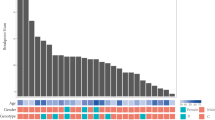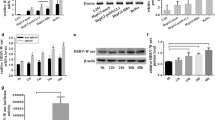Abstract
Integration of HBV DNA into host chromosomes was found in most of the patients with chronic hepatitis B (CHB). In this study, using inverse nested PCR (invPCR), we found the integration site chrX: 111,009,033, which inserted into the p21-activated kinase 3 (PAK3) gene in HepG2.2.15 cells. The viral-human chimeric transcripts were also observed and, significant differences of the copy numbers of integration site chrX: 111,009,033 (P = 0.012) and intra-cell HBV DNA levels (P = 0.027) were found between the cells with and without H2O2 treatment, respectively. This study may provide a novel insight into the elucidation of etiology of HBV integration.



Similar content being viewed by others
References
Ott JJ, Stevens GA, Groeger J, Wiersma ST (2012) Global epidemiology of hepatitis B virus infection: new estimates of age-specific HBsAg seroprevalence and endemicity. Vaccine 30:2212–2219
Trepo C, Chan HL, Lok A (2014) Hepatitis B virus infection. Lancet 384:2053–2063
Yan HL, Yang Y, Zhang L, Tang GN, Wang YZ, Xue G, Zhou WP, Sun SH (2015) Characterization of the genotype and integration patterns of hepatitis B virus in early- and late-onset hepatocellular carcinoma. Hepatology 61:1821–1831
Sung WK, Zheng H, Li S, Chen R, Liu X, Li Y, Lee NP, Lee WH, Ariyaratne PN, Tennakoon C et al (2012) Genome-wide survey of recurrent HBV integration in hepatocellular carcinoma. Nat Genet 44:765–769
Wang HC, Huang W, Lai MD, Su IJ (2006) Hepatitis B virus pre-S mutants, endoplasmic reticulum stress and hepatocarcinogenesis. Cancer Sci 97:683–688
Tu T, Budzinska MA, Shackel NA, Jilbert AR (2015) Conceptual models for the initiation of hepatitis B virus-associated hepatocellular carcinoma. Liver Int 35:1786–1800
Murakami Y, Saigo K, Takashima H, Minami M, Okanoue T, Bréchot C, Paterlini-Bréchotet P (2005) Large scaled analysis of hepatitis B virus (HBV) DNA integration in HBV related hepatocellular carcinomas. Gut 54:1162–1168
Saigo K, Yoshida K, Ikeda R, Sakamoto Y, Murakami Y, Urashima T, Asano T, Kenmochi T, Inoue I (2008) Integration of hepatitis B virus DNA into the myeloid/lymphoid or mixedlineage leukemia (MLL4) gene and rearrangements of MLL4 in human hepatocellular carcinoma. Hum Mutat 29:703–708
Tamori A, Yamanishi Y, Kawashima S, Kanehisa M, Enomoto M, Tanaka H, Kubo S, Shiomi S, Nishiguchi S (2005) Alteration of gene expression in human hepatocellular carcinoma with integrated hepatitis B virus DNA. Clin Cancer Res 11:5821–5826
Ding D, Lou X, Hua D, Yu W, Li L, Wang J, Gao F, Zhao N, Ren GP, Li LJ et al (2012) Recurrent targeted genes of hepatitis B virus in the liver cancer genomes identified by a next-generation sequencing-based approach. PLoS Genet 8:e1003065
Lau CC, Sun T, Ching AK, He M, Li JW, Wong AM, Co NN, Chan AW, Li PS, Lung RW et al (2014) Viral-human chimeric transcript predisposes risk to liver cancer development and progression. Cancer Cell 25:335–349
Petersen J, Dandri M, Bürkle A, Zhang L, Rogler CE (1997) Increase in the frequency of hepadnavirus DNA integrations by oxidative DNA damage and inhibition of DNA repair. J Virol 71:5455–5463
Tu T, Jilbert AR (2017) Detection of Hepatocyte clones containing integrated hepatitis B virus DNA using inverse nested PCR. Methods Mol Biol 1540:97–118
Ruan P, Dai XF, Sun J, He CP, Huang C, Zhou R, Cao Z, Ye L (2019) Different types of viral-host junction found in HBV integration breakpoints in HBV-infected patients. Mol Med Rep 19:1410–1416
Werle-Lapostolle B, Bowden S, Locarnini S, Wursthorn K, Petersen J, Lau G, Trepo C, Marcellin P, Goodman Z, Delaney WE IV (2004) Persistence of cccDNA during the natural history of chronic hepatitis B and decline during adefovir dipivoxil therapy. Gastroenterology 126:1750–1758
Tu T, Budzinska MA, Vondran FWR, Shackel NA, Urban S (2018) Hepatitis B virus DNA integration occurs early in the viral life cycle in an in vitro infection model via NTCP-dependent uptake of enveloped virus particles. J Virol. https://doi.org/10.1128/JVI.02007-17
Minami M, Poussin K, Brechot C, Paterlini P (1995) A novel PCR technique using Alu-specific primers to identify unknown flanking sequences from the human genome. Genomics 29:403–408
Jiang Z, Jhunjhunwala S, Liu J, Haverty PM, Kennemer MI, Guan Y, Lee W, Carnevali P, Stinson J, Johnson S et al (2012) The effects of hepatitis B virus integration into the genomes of hepatocellular carcinoma patients. Genome Res 22:593–601
Toh ST, Jin Y, Liu L, Wang J, Babrzadeh F, Gharizadeh B, Ronaghi M, Toh HC, Chow PK, Chung AY et al (2013) Deep sequencing of the hepatitis B virus in hepatocellular carcinoma patients reveals enriched integration events, structural alterations and sequence variations. Carcinogenesis 34:787–798
Zhao LH, Liu X, Yan HX, Li WY, Zeng X, Yang Y, Zhao J, Liu SP, Zhuang XH, Lin C et al (2016) Genomic and oncogenic preference of HBV integration in hepatocellular carcinoma. Nat Commun 7:12992
Li WY, Zeng X, Lee N et al (2013) HIVID: An efficient method to detect HBV integration using low coverage sequencing. Genomics 102:338–344
Boda B, Alberi S, Nikonenko I, Node-Langlois R, Jourdain P, Moosmayer M, Parisi-Jourdain L, Muller D (2004) The mental retardation protein PAK3 contributes to synapse formation and plasticity in hippocampus. J Neuro Sci 24:10816–10825
Zhou NN, Ding B, Agler M, Cockett M, McPhee F (2005) Lethality of PAK3 and SGK2 shRNAs to human papillomavirus positive cervical cancer cells is independent of PAK3 and SGK2 knockdown. PLoS ONE 10:e0117357
Bienvenu T, desPortes V, McDonell N, Carrié A, Zemni R, Couvert P, Ropers HH, Moraine C, van Bokhoven H, Fryns JP, et al (2000) Missense mutation in PAK3, R67C, causes X-linked non specific mental retardation. Am J Med Genet 93:294–298.
Li X, Zhang J, Yang Z, Kang J, Jiang S, Zhang T, Chen T, Li M, Lv Q, Chen X et al (2014) The function of targeted host genes determines the oncogenicity of HBV integration in hepatocellular carcinoma. J Hepatol 60:975–984
Dandri M, Burda MR, Bürkle A, Zuckerman DM, Will H, Rogler CE, Greten H, Petersen J (2002) Increase in de novo HBV DNA integrations in response to oxidative DNA damage or inhi- bition of poly(ADP-ribosyl)ation. Hepatology 35:217–223
Bill CA, Summers J (2004) Genomic DNA double-strand breaks are targets for hepadnaviral DNA integration. Proc Natl Acad Sci USA 101:11135–11140
Hu Z, Zhu D, Wang W, Li W, Jia W, Zeng X, Ding W, Yu L, Wang X, Wang L et al (2015) Genome-wide profiling of HPV integration in cervical cancer identifies clustered genomic hot spots and a potential microhomology-mediated integration mechanism. Nat Genet 47:158–163
Mladenov E, Magin S, Soni A, Iliakis G (2016) DNA double-strand-break repair in higher eukaryotes and its role in genomic instability and cancer: cell cycle and proliferation-dependent regulation. Semin Cancer Biol 37–38:51–64
Yang L, Ye S, Zhao X, Ji L, Zhang Y, Zhou PY, Sun J, Guan YF, Han YX, Ni C et al (2018) Molecular characterization of HBV DNA integration in patients with hepatitis and hepatocellular carcinoma. J Cancer 9:3225–3235
Schraufstatter IU, Hyslop PA, Hinshaw DB, Spragg RG, Sklar LA, Cochrane CG (1986) Hydrogen peroxide-induced injury of cells and its prevention by poly (ADP-ribose) polymerase. Proc Natl Acad Sci USA 83:4908–4912
Schraufstatter IU, Hinshaw DB, Hyslop PA, Spragg RG, Cochrane CG (1986) Oxidant injury of cells. J Clin Invest 77:1312–1320
Mason WS, Jilbert AR, Summers J (2005) Clonal expansion of hepatocytes during chronic woodchuck hepatitis virus infection. Proc Natl Acad Sci USA 102:1139–1144
Acknowledgements
The authors would like to thank Mrs. Francoise BERBY and Anaelle DUBOIS from Centre de Recherche en Cancérologie, Université Claude Bernard, Lyon for their technical assistance.
Funding
This study was funded by China Scholarship Council (Grant No. 201706275092).
Author information
Authors and Affiliations
Contributions
PR and IC conceived and designed the experiments. PR, XFD and JC performed the experiments. CH designed all the primers. RZ modified the English language of the manuscript. CPH analyzed the data. PR wrote the manuscript. All authors read and approved the final manuscript.
Corresponding authors
Ethics declarations
Conflict of interest
The authors declare that they have no conflicts of interests.
Research involving human and/or animals participants
This article does not contain any studies with human participants or animals performed by any of the authors.
Additional information
Edited by Zhen F. Fu.
Publisher's Note
Springer Nature remains neutral with regard to jurisdictional claims in published maps and institutional affiliations.
Rights and permissions
About this article
Cite this article
Ruan, P., Dai, X., Sun, J. et al. Integration of hepatitis B virus DNA into p21-activated kinase 3 (PAK3) gene in HepG2.2.15 cells. Virus Genes 56, 168–173 (2020). https://doi.org/10.1007/s11262-019-01725-4
Received:
Accepted:
Published:
Issue Date:
DOI: https://doi.org/10.1007/s11262-019-01725-4




